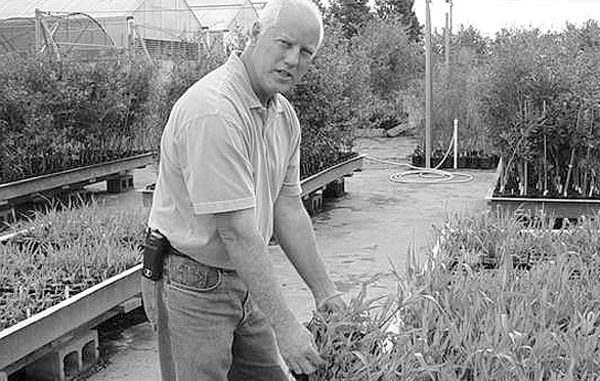
Vegetation is the primary binding feature that helps hold sediments together, protects against erosion and defines Louisiana’s wetlands.
In saline marsh, the primary vegetation present is smooth cordgrass. In brackish marsh, the vegetation usually is marshhay cordgrass.
The diversity of vegetation in fresh and intermediate marshes is much greater than in brackish and saline ones, but such vegetation often includes cattail, bullwhip, giant cutgrass, leafy threesquare and bulltongue.
All this vegetation keeps Louisiana’s wetlands healthy and productive, and is a critical part of the food chain that helps feed our remarkable fisheries.
If you’re out hunting or fishing, and see someone walking in the marsh or on a barrier island carrying wetland plants or plant parts, chances are good they work for the U.S. Department of Agriculture’s Natural Resources Conservation Service (NRCS).
NRCS plant specialists are helping to develop the vegetation that will most effectively reduce wetland loss and improve marsh areas. Collecting plants or plant parts from wetlands, for testing, is necessary to create what is referred to as an “assembly.” An assembly is the first step in developing a plant for eventual “release.” A release is a plant determined to be the best at producing the most desired qualities of that particular species.
Basically, what NRCS does to create an assembly is go out into the coastal areas and collect a lot of plants or plant cuttings of the same species from different areas. Plants growing in areas of extreme conditions are targeted for the characteristics that allow them to survive in that environment. That’s because those plants may already have the genetic characteristics (termed “genotype”) desired for eventual release.
In this time of increasing salinities or water depths, plants that can withstand those extremes will help slow the rate of wetland loss, or to revegetate areas that have subsided below sea level.
Once NRCS collects the plant specimens or parts, they are brought back to a central facility for propagation. In Louisiana, that facility is the plant materials center (PMC) in Golden Meadow. The Golden Meadow PMC is one of 26 PMCs spread across the United States. This one is dedicated to the specific purpose of developing plants for use in addressing coastal issues.
Staff there are developing salt and flood tolerant plants for shallow-water areas and marsh situations, plants for use on stabilizing dunes and upland areas on barrier islands, shrubs and trees for planting on upland ridges in coastal areas, and plants to revegetate coastal prairies.
At the Golden Meadow PMC, NRCS is working with more than 30 species of vegetation for potential use across the Gulf Coast. To date, they have developed official releases for the following six species: smooth cordgrass, marshhay cordgrass, bitter panicum, sea oats, seashore paspalum, and black mangrove.
Once an assembly is at the PMC, they are tested for various desired qualities in the greenhouses or in one of their 26 ponds. Plant qualities of interest include growth rate, seed production, rates of spreading, germination rates of seeds, etc.
“We are always looking for that unique plant that has the greatest potential,” said Gary Fine, director of the Golden Meadow PMC.
The plants are allowed to grow under varying conditions and measured for growth rate, seed production, seed viability, etc. Once the better plants of an assembly are identified, they are planted in various field locations for further testing.
After years of testing, the plant genotype of a species that best addresses a problem is identified and released. Once released, the plant is made available to the Louisiana Wetland Plant Growers Association free of charge for their propagation and sale to interested landowners.
The NRCS also provides training to growers to ensure they can successfully propagate each release.
Occasionally, collections in the field result in lucky finds. One occurred very recently. During a trip to view a wetland planting project in the Chandeleur Islands, staff of the National Marine Fisheries Service and NRCS saw a lone bitter panicum plant growing on one of the islands.
A few cuttings of the plant were taken to the Golden Meadow PMC for propagation and testing. One problem with the bitter panicum release at present is that while it spreads great by sending out “tillers,” they produce sterile seeds.
It was found that the progeny of this one plant actually produced viable seeds. If this plant genotype proves to be as successful as the current bitter panicum release, it may be more desirable for planting the dunes on barrier island and beach nourishment projects because it would more likely spread faster and thereby help trap sand better.
This plant has been propagated, and is presently being tested by NRCS on the recently completed beach nourishment project near Holly Beach in Cameron Parish.
While the NRCS provides releases free of charge to the wetland plant growers, they also have an extensive network of local field offices available to help landowners with advice and guidance in the use of wetland plants.
If you have property with an eroding shoreline you might like to try to protect against wave erosion, or shallow-water areas you want to try to revegetate with plants more tolerant of flooding, NRCS might be able to give you assistance.
Look in the phone book under the United States Department of Agriculture, Natural Resources Conservation Service to find the nearest local field office.
Richard Hartman is the leader of the Louisiana Habitat Conservation Division of NOAA Fisheries.


